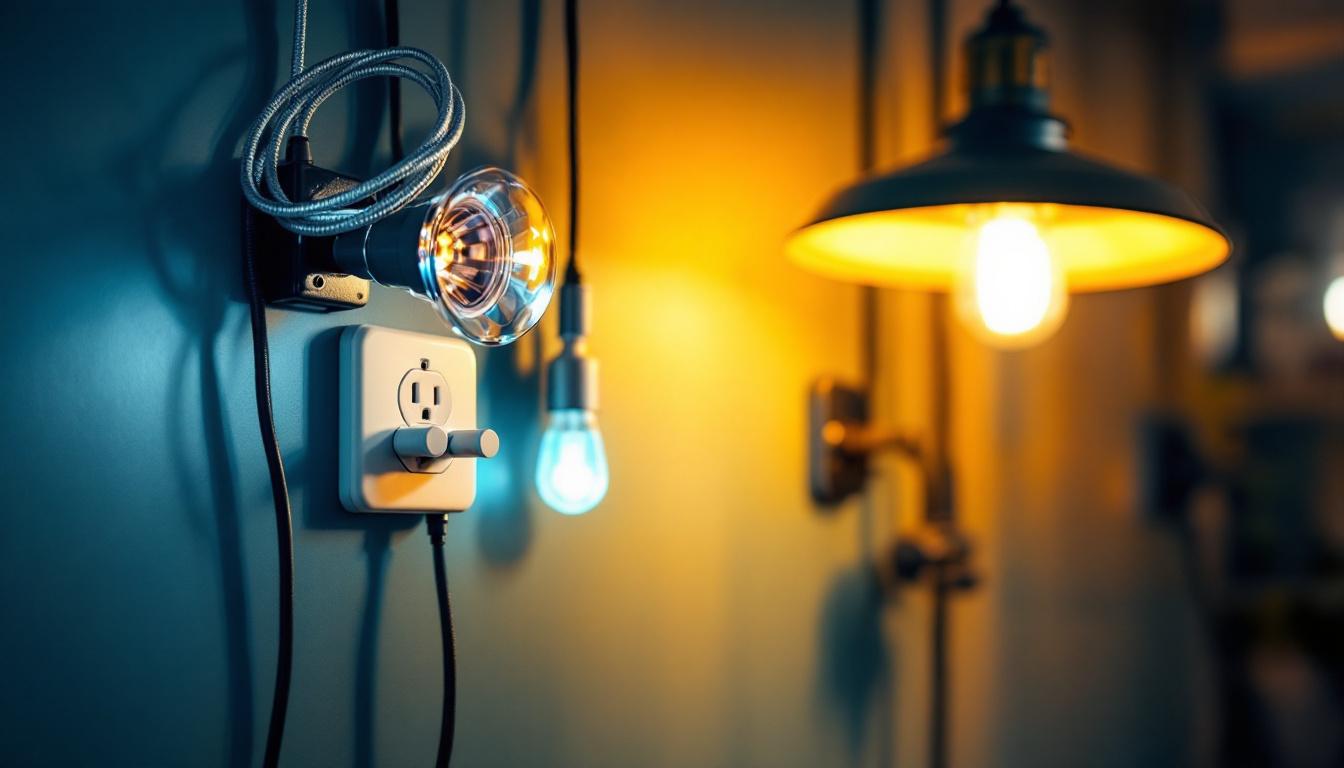
In the realm of lighting installations, the importance of a reliable outlet electrical supply cannot be overstated. This critical component serves as the backbone of any lighting system, ensuring that fixtures operate efficiently and safely. For lighting contractors, understanding the nuances of outlet electrical supply is essential for delivering high-quality installations that meet both client expectations and regulatory standards.
Outlet electrical supply refers to the provision of electrical power through outlets, which are integral to connecting lighting fixtures. The effectiveness of a lighting installation hinges on a well-planned electrical supply system. This section delves into the various roles that outlet electrical supply plays in lighting installations.
One of the primary functions of outlet electrical supply is to distribute power to various lighting fixtures. A well-designed electrical layout ensures that each fixture receives the appropriate voltage and current, which is crucial for optimal performance. Inadequate power distribution can lead to flickering lights, inconsistent brightness, and even damage to the fixtures themselves.
Moreover, understanding the load capacity of each outlet is vital. Lighting contractors must ensure that the total wattage of all connected fixtures does not exceed the outlet’s rating. This consideration not only enhances performance but also safeguards against potential electrical hazards. For instance, using LED fixtures, which consume less power than traditional incandescent bulbs, can allow for more fixtures to be connected safely to a single outlet, optimizing energy use while maintaining brightness levels.
Safety is paramount in any electrical installation, and outlet electrical supply plays a significant role in ensuring compliance with safety regulations. Adhering to local electrical codes and standards is essential to avoid legal repercussions and ensure the safety of the installation.
Proper grounding and circuit protection mechanisms, such as circuit breakers and fuses, are critical components of a safe electrical supply system. These features help prevent electrical shocks and reduce the risk of fire hazards, making them indispensable in lighting installations. Additionally, incorporating surge protectors can further enhance safety by safeguarding against voltage spikes that could potentially damage sensitive lighting equipment. Regular inspections and maintenance of the electrical supply system are also crucial to ensure ongoing compliance and safety, as wear and tear over time can lead to unforeseen issues that compromise the integrity of the installation.
Understanding the different types of outlet electrical supply is crucial for lighting contractors. Each type serves specific purposes and is suited for various applications. This section explores the most common types of electrical outlets used in lighting installations.
Standard outlets are the most commonly used type in residential and commercial lighting installations. These outlets typically provide 120 volts of electrical power and are suitable for a wide range of lighting fixtures. They are versatile and can accommodate both incandescent and LED bulbs, making them a popular choice for contractors.
However, it is essential to consider the amperage rating of standard outlets. For instance, a 15-amp outlet may not be sufficient for high-wattage fixtures. Therefore, careful planning is necessary to ensure that the right outlet type is used for the specific lighting application.
In some cases, specialty outlets are required for specific lighting applications. These outlets may provide higher voltage or unique configurations to accommodate specialized fixtures. For example, 240-volt outlets are often used for commercial lighting installations that require more power.
Additionally, GFCI (Ground Fault Circuit Interrupter) outlets are crucial in areas where moisture is present, such as bathrooms or outdoor spaces. These outlets help prevent electrical shocks by cutting off power when a ground fault is detected, making them essential for safety in lighting installations.
Designing an effective outlet electrical supply system involves several considerations. Lighting contractors must take into account various factors to ensure optimal performance and safety. This section highlights some of the key factors influencing outlet electrical supply design.
Accurate load calculations are fundamental to designing a reliable outlet electrical supply system. Contractors must assess the total wattage of all lighting fixtures to determine the necessary circuit capacity. This calculation helps prevent overloading circuits and ensures that each fixture operates efficiently.
In addition to wattage, contractors should also consider the starting current of certain fixtures, such as fluorescent lights or LED drivers. These fixtures may draw more power during startup, necessitating additional capacity in the electrical supply system.
When designing an outlet electrical supply system, it is wise to consider potential future expansion. Clients may wish to add more lighting fixtures or upgrade existing ones down the line. By incorporating additional capacity into the initial design, contractors can save time and resources in the future.
Planning for future expansion may involve installing extra outlets or ensuring that the electrical panel can accommodate additional circuits. This foresight can enhance client satisfaction and streamline future projects.
Implementing best practices during the installation of outlet electrical supply systems is crucial for ensuring safety and efficiency. Lighting contractors should adhere to established guidelines to achieve optimal results. This section outlines some essential installation best practices.
Utilizing proper wiring techniques is fundamental to a successful outlet electrical supply installation. Contractors should ensure that all wiring is appropriately sized for the circuit and that connections are secure. Using high-quality materials can also enhance the reliability of the installation.
Additionally, following the correct color coding for wiring helps prevent confusion and errors during installation. This practice is especially important when working with multiple circuits or outlets, as it ensures that each connection is made correctly.
Once the outlet electrical supply system is installed, thorough testing and commissioning are essential. This process involves verifying that all outlets are functioning correctly and that there are no issues with voltage or current. Conducting these tests helps identify potential problems before the system is put into operation.
Moreover, documenting the testing results can provide valuable information for future maintenance and troubleshooting. This practice not only enhances the reliability of the installation but also builds trust with clients.
Despite careful planning and execution, lighting contractors may encounter challenges during the installation of outlet electrical supply systems. Understanding these challenges can help contractors prepare and develop effective solutions. This section discusses some common challenges faced in this area.
In many lighting installations, space constraints can pose significant challenges. Limited access to certain areas may make it difficult to install outlets or run wiring effectively. Contractors must be creative in finding solutions that comply with safety regulations while maximizing the use of available space.
Utilizing compact outlet designs or strategically placing outlets can help overcome these challenges. Additionally, considering the layout of the lighting fixtures can facilitate more efficient wiring and outlet placement.
Compatibility issues can arise when integrating new lighting fixtures with existing outlet electrical supply systems. Contractors must ensure that the voltage and current requirements of the new fixtures align with the capabilities of the existing outlets. Incompatibility can lead to performance issues or even damage to the fixtures.
To mitigate these challenges, thorough research and planning are essential. Contractors should familiarize themselves with the specifications of both the fixtures and the outlet electrical supply system to ensure seamless integration.
As technology continues to evolve, the future of outlet electrical supply in lighting installations is poised for significant advancements. Emerging trends and innovations are shaping the way lighting contractors approach their projects. This section explores some of the anticipated developments in this field.
Smart lighting systems are becoming increasingly popular in both residential and commercial settings. These systems often require specialized outlet electrical supply configurations to accommodate advanced features such as remote control, automation, and energy monitoring.
Contractors must stay informed about the latest smart lighting technologies and their electrical requirements. This knowledge will enable them to design and install outlet electrical supply systems that support these innovative solutions, enhancing the overall functionality of the lighting installations.
With a growing emphasis on energy efficiency and sustainability, outlet electrical supply systems are also evolving to meet these demands. The integration of energy-efficient lighting fixtures, such as LEDs, requires careful consideration of the electrical supply to maximize their benefits.
Contractors can play a pivotal role in promoting sustainability by choosing energy-efficient components and designing systems that minimize energy consumption. This approach not only benefits the environment but also helps clients reduce their energy costs in the long run.
In conclusion, outlet electrical supply is a critical element in lighting installations that should not be overlooked by lighting contractors. Understanding its role in power distribution, safety compliance, and the various types of outlets available is essential for successful installations. By considering factors such as load calculations, future expansion, and installation best practices, contractors can ensure that their lighting projects are efficient, safe, and reliable.
As the industry continues to evolve, staying informed about emerging trends and technologies will empower lighting contractors to deliver cutting-edge solutions to their clients. By prioritizing outlet electrical supply in their designs and installations, contractors can enhance the quality of their work and contribute to a brighter, more sustainable future.
Ready to elevate your lighting installations with the highest quality supplies? Look no further than LumenWholesale for all your outlet electrical supply needs. Our spec-grade lighting products are designed to meet the stringent demands of your projects, ensuring you deliver efficiency, safety, and reliability every time. With unbeatable wholesale prices and the convenience of free shipping on bulk orders, LumenWholesale is your go-to source for superior lighting without the inflated markups. Don’t compromise on quality or value — Wholesale Lighting at the Best Value is just a click away. Make the smart choice and partner with us for your next lighting project.

Explore the advantages and drawbacks of patio string bulbs for lighting contractors.

Discover essential insights into US LED lighting that every lighting contractor needs to know.

Discover essential compliance guidelines for fluorescent light fixtures in this comprehensive guide tailored for lighting contractors.

Discover the transformative impact of post solar lighting on the future of sustainable construction.